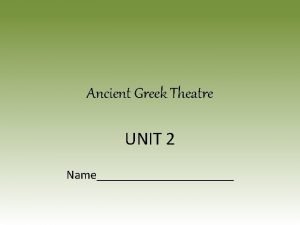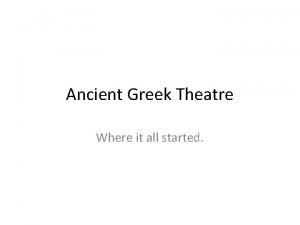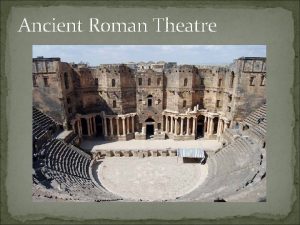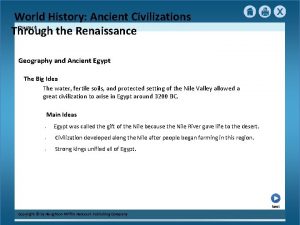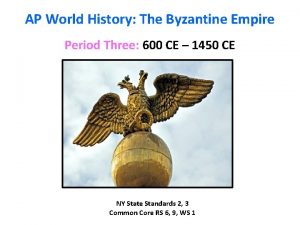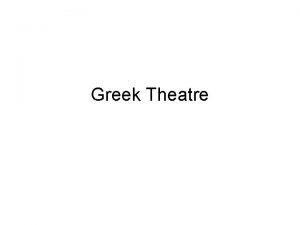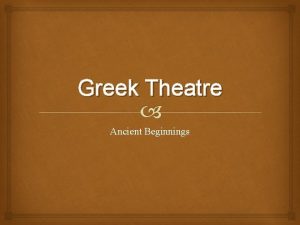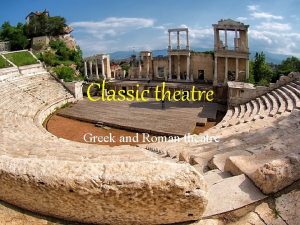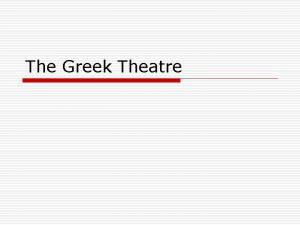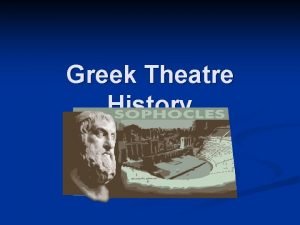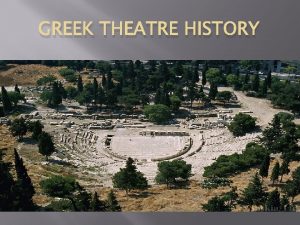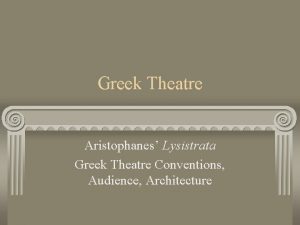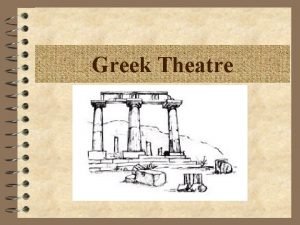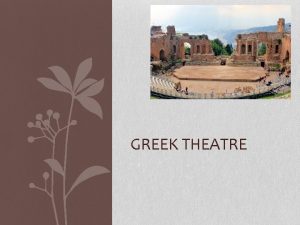Theatre History The Ancient World Greek Theatre The















- Slides: 15

Theatre History: The Ancient World – Greek Theatre The story of the beginning of modern western theatre began around the fifth century BC in Greece. Emerging from the religious ceremonies and rituals of the Greeks was the Greek tragedy or play. It was a slow process of development, although many of the plays are so great they are still performed today.

DIONYSUS – The Wine God The Greeks had many gods such as Dionysus, the god of wine, pleasure and fertility. Every year in the city of Dionysia, the Greeks held competitions and festivals to honour this important god. It was a week long feast of fun, plays, rituals, food, drinking, dancing and worship. Thousands of people gathered together to celebrate and participate in the outdoor festivities which were often bordering on riotous.

The Theatre of Dionysus The first theatres were outdoors and included an altar to Dionysus. Actors could go backstage to change costumes and masks. The plays were presented by a chorus of people who performed as a group not as individuals. The chorus would dance, sing and speak in unison.

• Theatre of Dionysus was built beneath the Athenian Acropolis and was very central. Spectators originally sat on a slope which was later built up with stone seats, like a semi-circle stadium. A permanent building was set up called a scene house and this provided the background ‘scenery’ for plays. Instead of building new sets for different plays, other techniques were used.

If the action was supposed to be taking place by the sea, for example, the actors would mention it in their dialogue, rather than have painted backdrops of the sea as later would happen. If something happened, it was often ‘backstage’ or indoors and again it would be mentioned in the dialogue or proof would be brought back, such as a dead body. Ancient Greek Theatre was not meant to be representational or pretending to be realistic.

Greek Drama • The three greatest playwrights are thought to be Aeschylus (525 - 456 BC), Sophocles (496 – 406 BC, and Euripides (480 – 406 BC), who along with others also competed in the drama competitions in the fifth century BC. All three wrote tragic plays.

Tragic Plays Typical features of a Greek tragedy included: • A prologue or introduction where background information is explained and introduced • Five episodes each divided by • Choral passages where the chorus sing and dance in unison

Most of these plays were religious and dealt with theme of the power of the gods and the relationship between the many Greek gods and men. Other themes included suffering, the role of evil, fate versus free will, and deep tragic events where the hero usually dies in the end. Later, Greek comedy plays were produced which were energetic and lively. Aristophanes (448 – 380 BC) was one of the best known comedy playwrights.

Greek Style As plays were performed to an incredible 15, 000 to 100, 000 people at a time, many features developed to overcome the problem of being seen or heard by such loud crowds. Greek theatre was big!

Such features included: • MASKS Actors wore large masks which represented what type of character they were playing and allowed the audience to tell them apart easily. They could also become another character with a simple mask change, and males could play female roles.

• COSTUMES Actors wore high platform shoes to add height and brightly coloured clothes and sometimes, head pieces. Thus the appearance was often larger than life.

• ACTING Many of the plays were delivered in singing, dancing and poetry. Because small details could not be seen from far away, actions on stage were deliberate, slow, easily recognised and simple. Voice skills needed to be well developed so that words could be heard by all and being able to project one’s voice was essential.

• CHORUS Although the first Greek performances featured only a chorus of actors, later individual characters broke away and took on major roles. The chorus was still kept and their role was to divide the episodes of the play, give advice and express opinions about the actions of the characters, reflect audience feelings and add to the excitement, mood and drama of the performance. The chorus remained on stage at all times.

• MUSIC Music was important as it added to the action on stage and accompanied the chorus.

• THE MESSENGER The Messenger would report actions that took place on stage. These would be extended speeches, like stories, usually telling of violent actions that could not be performed on stage.
 Timeline of greek theatre
Timeline of greek theatre Greek theater costumes
Greek theater costumes Parts of a greek theater
Parts of a greek theater Why did they wear masks in greek theatre
Why did they wear masks in greek theatre Greek stage advantage
Greek stage advantage Greek theater architecture
Greek theater architecture Conventions of greek theatre
Conventions of greek theatre Ancient greek theatre masks
Ancient greek theatre masks Ancient roman theatre history
Ancient roman theatre history History of greek drama
History of greek drama History alive the ancient world chapter 8
History alive the ancient world chapter 8 History alive chapter 14
History alive chapter 14 From hunters and gatherers to farmers chapter 3
From hunters and gatherers to farmers chapter 3 Ancient civilizations through the renaissance
Ancient civilizations through the renaissance Greek fire definition ap world history
Greek fire definition ap world history Ap world history chapter 25 africa and the atlantic world
Ap world history chapter 25 africa and the atlantic world


